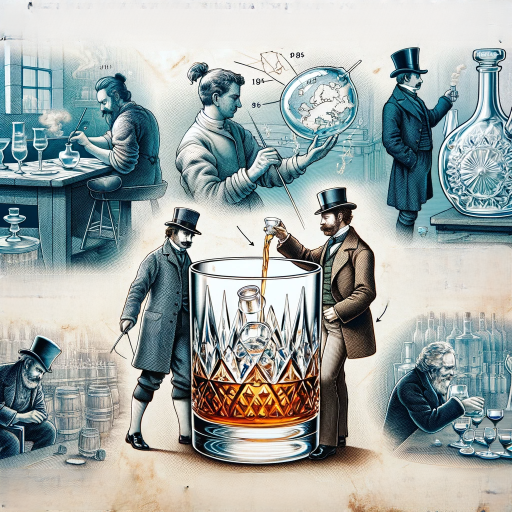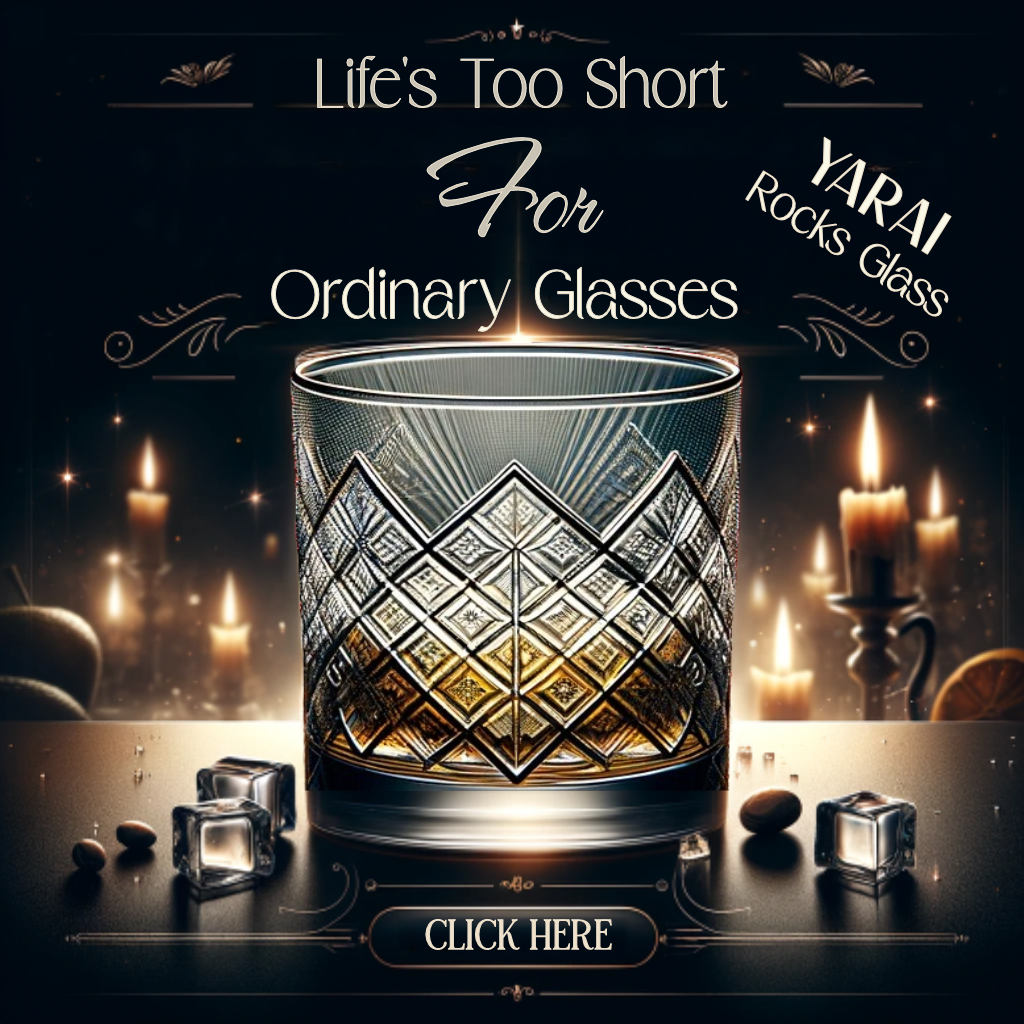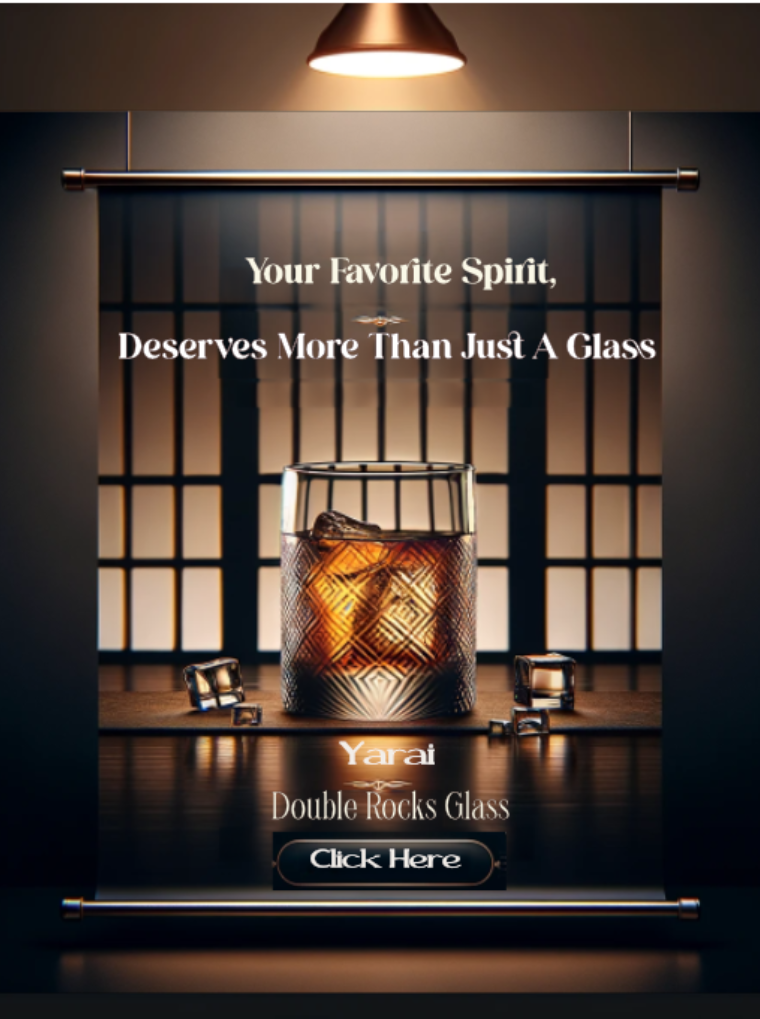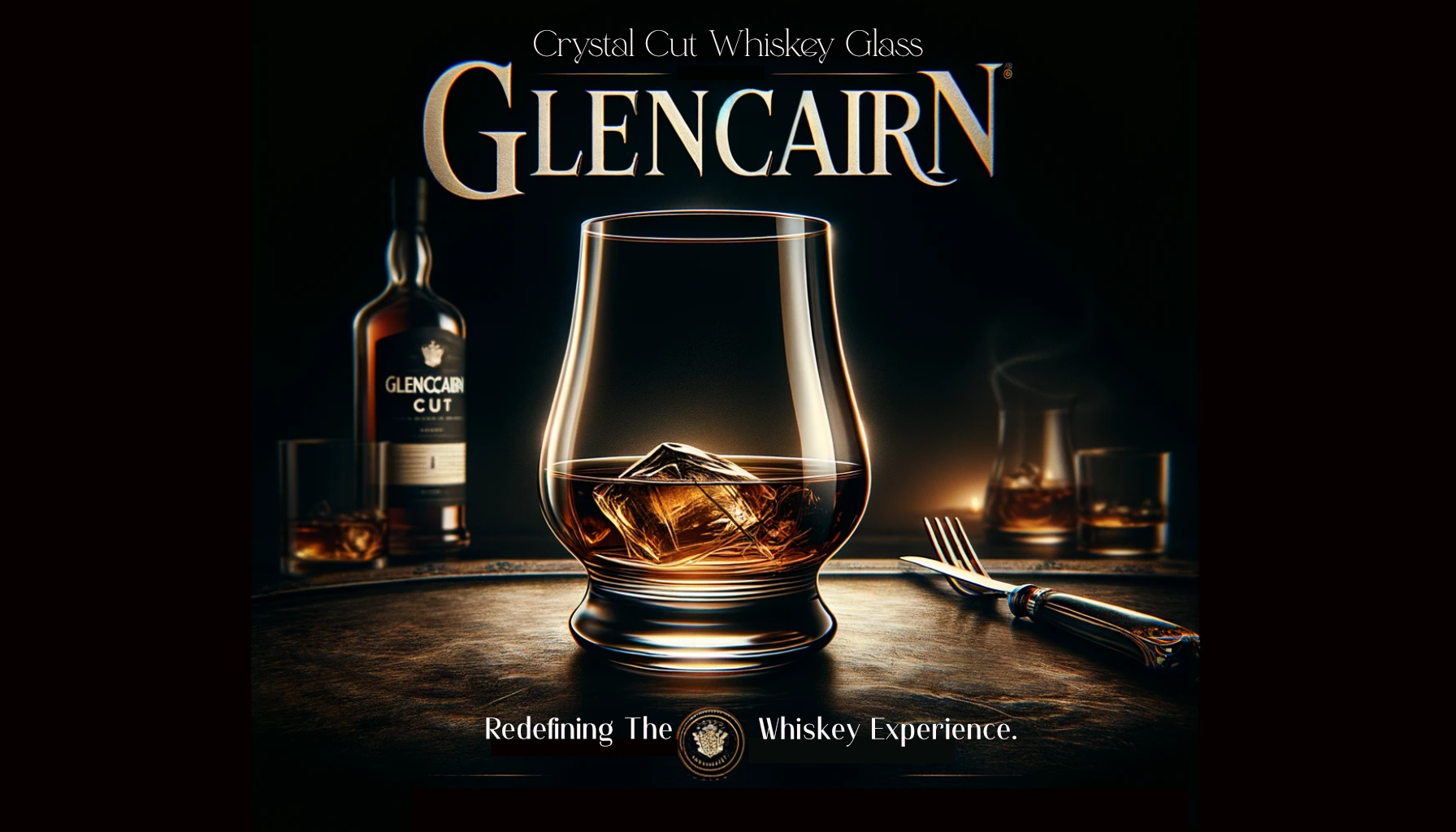Crystal Whiskey Glasses: Masterfully Crafted for the Aficionado
Development of Crystal Glassware
The term “crystal” refers to a type of glass that is more transparent and has a higher refractive index than ordinary glass. In the 15th century, glassmakers on Murano, an island near Venice, discovered that adding lead oxide to glass made it clearer and easier to cut and engrave, paving the way for the creation of high-quality crystal whiskey glasses.
Advancements in England
In 1674, George Ravenscroft patented the first lead crystal. It was clearer and more brilliant than any glass previously produced. Furthering the development of lead crystal glassware in England. Setting a new standard for quality and clarity. Which had a significant impact on the production of crystal whiskey glasses.
Whiskey and Crystal Glassware
The association between whiskey and crystal glassware began to develop in the 19th century. In Scotland and Ireland specifically, the popularity of whiskey grew, and the preferred choice for enjoying this spirit was crystal whiskey glasses.
Symbol of Status and Quality
Crystal whiskey glasses and crystal decanters became symbols of status and quality. The weight and feel of crystal whiskey glasses added a sense of luxury to the drinking experience. The color of the whiskey was able to fully be appreciated because of the crystal’s clarity and brilliance.
Craftsmanship and Collectability
The craftsmanship involved in making crystal whiskey glasses became more intricate. The detailed cutting and engraving made crystal whiskey glasses decorative and collectible in addition to their functionality.
Modern Times
Today, many whiskey aficionados favor crystal whiskey glasses due to their rich heritage, aesthetic appeal, and the manner in which they enhance the whiskey tasting experience.
The Best Type of Glass for Whiskey
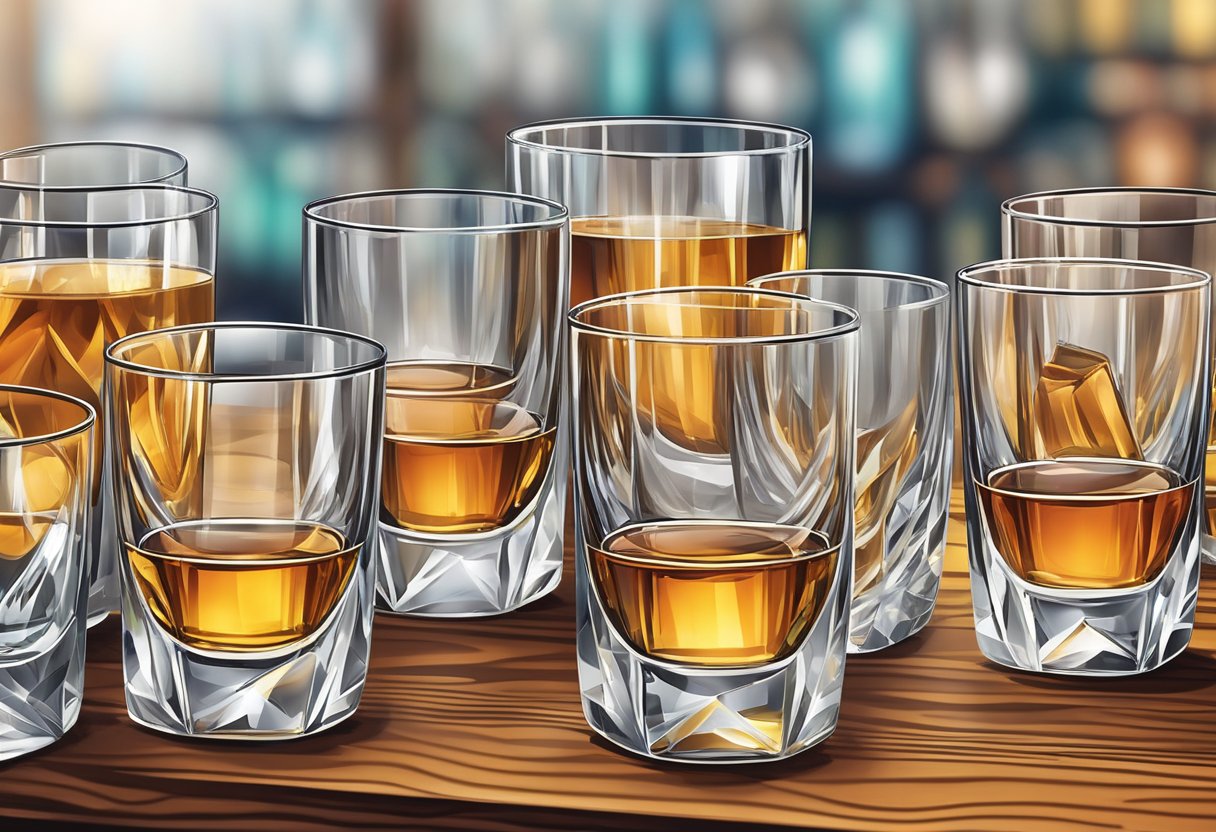
If you were to ask me, “What is the best type of glass for whiskey? The standard response when growing up was, “Whatever type of glass I am holding, right here!” We really didn’t even need a glass. Talk about the perfect pour, we could waterfall whiskey as perfect as a circle.
Ask the same question now, my answer would be, “there isn’t one.” When all said and done, personal preference will play a significant role in choosing a whiskey glass. And the best glass is the one that provides you with the most enjoyable whiskey drinking experience. The key is to choose a glass that enhances your personal enjoyment of whiskey, whether it’s focusing on the aroma, the flavor, or the overall experience. Although, there are some factors you can consider.
Factors to consider when choosing crystal whiskey glasses
When selecting crystal whiskey glasses, there are a few key factors to consider.
- Firstly, the quality of the crystal itself is of utmost importance. Look for glasses made from lead-free crystal; you’ll understand why further down this write up.
- Opt for glasses that are handcrafted, as this ensures the highest level of craftsmanship and attention to detail.
- Another factor to consider is the thickness of the glass. Thicker glasses tend to be sturdier and can retain temperature better, making them ideal for serving whiskey on the rocks. Thinner glasses, on the other hand, allow for a more refined drinking experience, as they showcase the clarity and brilliance of the whiskey.
- Finally, consider the design and aesthetics of the glass. Crystal whiskey glasses come in a wide range of styles and patterns, from intricately cut designs to sleek and minimalist options. Choose a design that speaks to your personal style and adds a touch of elegance to your whiskey-drinking ritual.
A significant portion of what we perceive as taste is actually due to our sense of smell. Therefore, releasing more aromas can lead to a more nuanced and enjoyable tasting experience. Designers create crystal whiskey glasses to enhance the experience of drinking whiskey. Different glasses cater to different aspects of the whiskey. Either focusing on aroma concentration, allowing the spirit to breathe, or accommodating ice and mixers in a cocktail. Let me give you some examples.
The Whiskey Glass Lineup
- Glencairn Glass: Specifically designed for whiskey tasting. The Glencairn glass has a unique shape. A wide bowl that narrows to a relatively narrow opening. This is a widely recommended glass for whiskey, especially single malt Scotch. Because its tulip shape helps concentrate the aromas at the top of the glass, enhancing the tasting experience.
- Snifter: Next is the Brandy Snifter is a short-stemmed glass used for brandy. It has a similar tulip shape as the Glencairn, but it is generally larger and has a wider bowl to allow the spirit to breathe by swirling it around in the glass. The design of the brandy snifter is intended to capture and intensify the complex aromas of brandy.
- Rocks Glass (or Old Fashioned Glass): Then we have the most commonly type of tumbler used for whiskey, the rocks glass. It’s a versatile glass, suitable for drinking it neat, on the rocks, or in cocktails like an Old-Fashioned. It has a wide brim and a solid base, making it great for muddling ingredients for cocktails.
- Highball Glass: This tall glass is best for whiskey cocktails like a Highball or a Whiskey Sour. Its height makes it ideal for drinks with mixers.
- Tasting Glass (or Copita): Similar to a Glencairn but often with a stem, this glass is also designed for nosing and is often used in formal whiskey tastings.
- Neat Glass: A relatively newer design, Neat glasses are usually designed with a broad base that narrows into a flared top. This distinctive shape aims to increase the area for the liquid to evaporate, and the widened rim effectively spreads out the alcohol fumes, reducing their intensity near the nose.
- Whiskey Nosing Glasses: These are designed to enhance the nosing process, allowing for a better appreciation of the whiskey’s complexity.
- Lead-Free Crystal: This is a safer option compared to traditional leaded crystal. Lead-free crystal glasses are known for their clarity, durability, and fine craftsmanship.
By clicking on either of the images, you will be directed over to Amazon’s website.
This table summarizes the characteristics and uses of each glass type to enhance the whiskey-drinking experience.
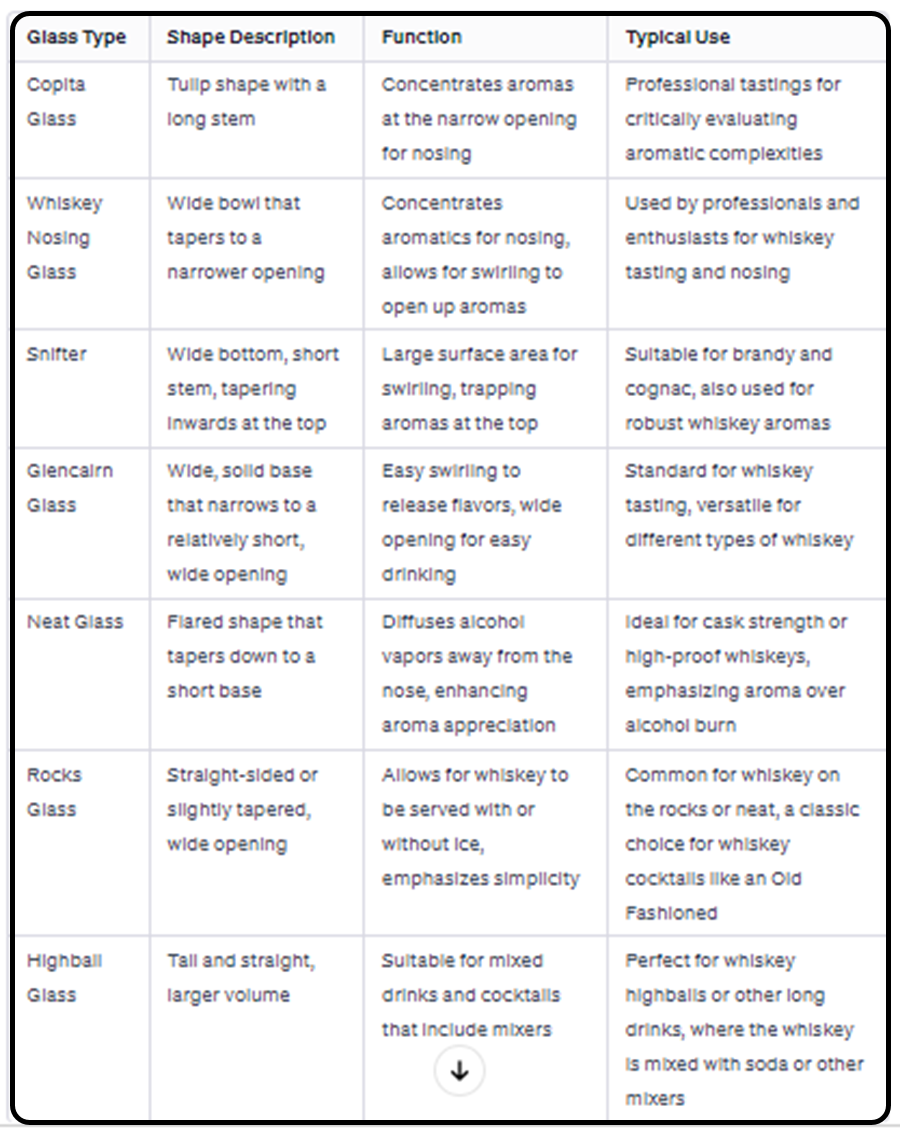
Each glass offers a different experience in terms of nosing and tasting the whiskey. The Glencairn and Snifter are more for a sensory tasting experience, while the Rocks and Highball glasses are more for casual drinking or cocktails.
The Perfect Glass for Every Type of Whiskey
Considering the type of whiskey and its characteristic flavors and aromas can enhance your drinking experience. Several popular types of glasses are commonly used for the specific type of whiskey you are drinking. Here’s a more detailed look at how those glasses enhance specific characteristics of various whiskey styles influencing your choice of glass:
- Single Malt Scotch: For single malts, a Glencairn glass is often preferred. Its tulip shape helps concentrate the complex aromas at the top of the glass, allowing you to fully appreciate the depth and subtlety of the spirit. This is particularly beneficial for single malts, which are known for their nuanced flavors and aromas.
- Aged Whiskeys and Bourbons: For aged whiskeys and bourbons, a snifter might be more appropriate. The wide bowl of the snifter allows swirling the whiskey to help it breathe, revealing the layers of aroma developed during the aging process. It’s especially suitable for enjoying the rich, deep flavors of aged spirits.
- Cask Strength Whiskey: When drinking cask strength whiskey, which is higher in alcohol content, a glass like the Neat Glass might be preferable. Its design helps to disperse the alcohol and emphasize the aroma, making the experience of drinking a high-proof spirit more enjoyable.
- Whiskey Cocktails: If you’re drinking whiskey cocktails, the type of glass can vary depending on the cocktail. Use a rocks glass for cocktails served with ice, such as an Old Fashioned, and choose a highball glass for longer drinks mixed with soda or other mixers, like a Whiskey Sour or a Highball.
- Irish Whiskey and Canadian Whiskey: These types of whiskey are often lighter and smoother. A standard rocks glass or even a Glencairn can be suitable, as they allow you to enjoy the whiskey without overly concentrating the aromas, which can be more subtle in these spirits.
- Rye Whiskey: For rye whiskey, which is known for its spicy and fruity characteristics, a rocks glass or a Glencairn can work well. The choice depends on whether you want to focus on savoring its complexity (Glencairn) or enjoying it in a more relaxed way, possibly with ice (rocks glass).

This table above provides a clear guide on which glassware to use for different types of whiskey, considering their unique characteristics and how the shape and size of the glass can enhance the tasting experience.
The table below provides each glassware type and the recommended whiskey glass on how it can best present the characteristics of the whiskey style, whether it’s concentrating aromas, allowing room for ice, or preventing hand warmth from affecting the drink’s temperature. This table should serve as a handy reference for anyone interested in whiskey tasting and looking to enhance their experience with the appropriate glassware.
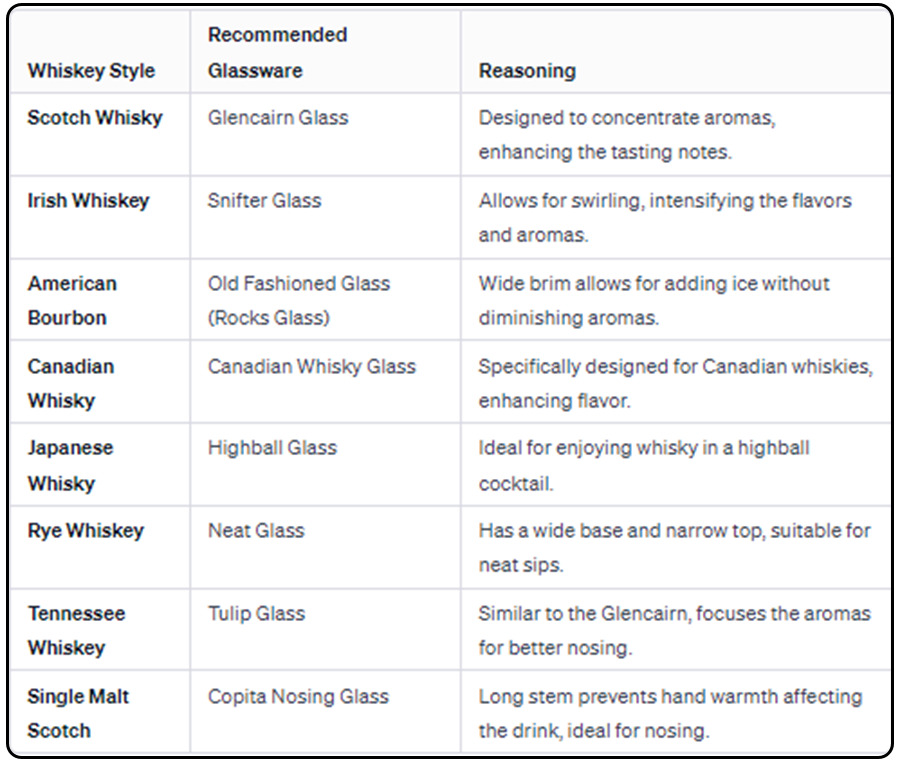
Whiskey Glass vs Tumbler
The terms “whiskey glass” and “tumbler” can sometimes be used interchangeably, but they do have distinct meanings which can help differentiate between different types of drinkware.
Whiskey Glass is a general term that can refer to any glass in which whiskey is served. We discussed various specific types of whiskey glasses in the above section, focusing on how their design, more specifically shape and size, influences the tasting and enjoyment of whiskey. ‘Whiskey Glass’ is a general term referring to any glass used for serving whiskey.
The next question you may have might be, “What is the difference between a whiskey glass and a tumbler? Subsequently one of the key differences between a whiskey glass and tumbler is the design and shape.
Tumbler: A tumbler is a type of glass that is typically short, with a solid base, and often with straight sides, though there are variations. Tumblers can be used for a variety of drinks, including whiskey. They tend to have a larger volume, accommodating ice and mixers along with the whiskey.
Typically, people use rocks glasses for whiskey served neat, with ice (on the rocks), or for simple whiskey cocktails like the Old Fashioned. In contrast, the specific design of a Glencairn glass enhances the whiskey drinking experience, with shapes that concentrate aromas and flavors. So, while you can use any tumbler as a whiskey glass, not all whiskey glasses are tumblers.
Exploring the Excellence of Crystal Whiskey Glasses
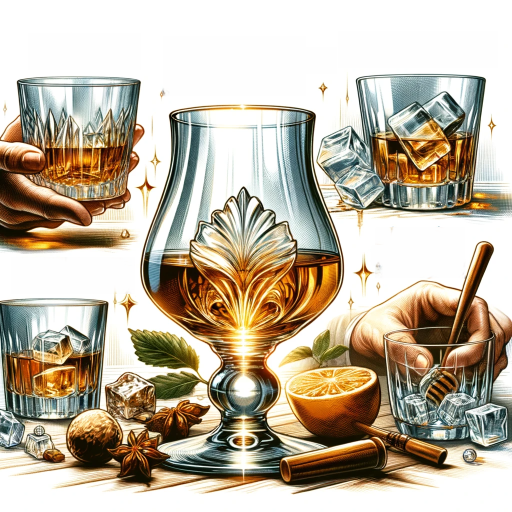
You might be wondering, “What’s the difference between crystal whiskey glasses and regular whiskey glasses?” The key distinction lies in the materials used to craft them, which results in different properties.
Historically, manufacturers often made crystal whiskey glasses from lead crystal, a type of glass containing lead oxide. This has implications for health-conscious individuals, as lead can seep into drinks over time. For example, storing whiskey in a crystal decanter, as opposed to its original bottle, poses the risk of lead contamination over prolonged periods. Research has consistently shown that consuming any amount of lead is unsafe.
Now before we go any further, it’s important to note that there are also high-quality lead-free crystal glasses available, which offer similar benefits in terms of clarity, weight, and sound, but without the lead content. This can be a consideration for those concerned about lead leaching, especially when the glasses are used frequently over a long period. Lead-free crystal options are becoming increasingly popular.
Why is it lead crystal used at all? Well, it’s the lead oxide that gives the crystal weight and also gives the crystal its characteristic sparkle and clarity.
Clarity and Brilliance:
- Visual Appeal: Crystal is prized for its exceptional clarity. This transparency allows whiskey enthusiasts to fully appreciate the color and consistency of their drink, which is an integral part of the whiskey tasting experience in crystal whiskey glasses.
- Refractive Quality: Crystal, especially lead crystal, has a higher refractive index compared to regular glass. This means it bends light more effectively, adding brilliance and sparkle to the whiskey in crystal whiskey glasses, which enhances its visual appeal.
Weight and Texture:
- Tactile Experience: Crystal whiskey glasses, tends to be heavier than standard glass. This weightiness provides a satisfying, substantial feel in the hand, contributing to the overall experience of drinking whiskey.
- Aesthetics: Crystal Whiskey glasses can also be cut into intricate patterns, thanks to their pliability.
Sound:
- Pleasing Sound: The clink of crystal whiskey glasses is distinct and more resonant compared to regular glass. This sound can enhance the social experience of drinking whiskey, marking moments of celebration and togetherness.
Durability:
- Stability and Durability: The added weight of crystal whiskey glasses also means more stability, reducing the likelihood of spilling.
Purity of Taste:
- High-quality crystal is non-porous, which means it doesn’t affect the whiskey’s flavor, ensuring the taste remains unaltered. However, you now know that it’s important to consider the potential for lead contamination in traditional lead crystal over time. Fortunately, with the growing popularity of lead-free crystal, there have been significant advancements. These improvements mean that high-quality lead-free crystal whiskey glasses are also non-porous. Guaranteeing an untainted and pure whiskey tasting experience.
Price:
- Pricier: Crystal glasses are often more expensive due to their material quality and the craftsmanship involved in their production.
The choice between crystal and regular glass whiskey glasses can depend on personal preferences regarding aesthetics, weight, texture, and price, as well as considerations about health and practicality. People often choose crystal glasses for their beauty and the special touch they add to the whiskey-drinking experience, while they opt for regular glasses for their practicality and everyday use.
Cleaning Crystal Whiskey Glasses: Best Practices
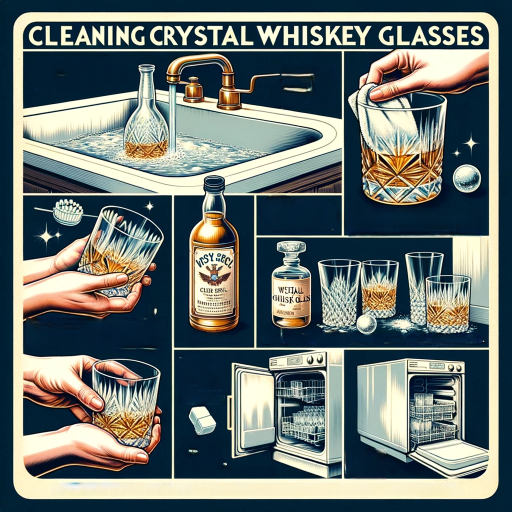
Cleaning crystal whiskey glasses properly is important to maintain their clarity, brilliance, and longevity. Here’s the best way to clean them:
Hand Washing (Recommended)
- Warm Water Usage: Begin by filling a sink or basin with warm water, ensuring it’s not too hot. Excessively hot water can lead to thermal shock, causing crystal glasses to crack or break.
- Mild Soap: Introduce a small quantity of gentle dish soap into the water. It’s advisable to avoid harsh or heavily scented detergents, as they can leave behind scratches or residue.
- Soft Cleaning: Employ a soft cloth or sponge for cleaning the glasses. Steer clear of harsh scrubbers or brushes, which have the potential to scratch the crystal surface.
- Thorough Rinsing: Make sure to rinse the glasses under warm running water to eliminate all traces of soap. Any residual soap can alter the flavor of the whiskey.
- Efficient Drying: Dry the glasses using a lint-free towel. Crystal glasses are susceptible to water marks, so it’s crucial to dry them completely.
Dishwasher (If Necessary)
If the crystal whiskey glasses are labeled dishwasher safe:
Additional Tips
Caution
Proper storage of crystal whiskey glasses is crucial for keeping them clear, undamaged, and ready for use. Here’s how to best store your crystal whiskey glasses:
Thorough Cleaning:
- Make sure to wash the glasses well before storing. They should be completely dry to avoid any marks or streaks.
No Stacking:
- Avoid stacking your crystal glasses. This can create pressure and rubbing, leading to potential chips or cracks.
Vertical Storage:
- Keep the glasses upright when storing. Placing them on their rims could stress and damage the fragile edges.
Stable Location:
- Use a shelf or cabinet that’s stable and free from vibrations. Too much movement might cause the glasses to hit each other and break.
Space Between Glasses:
- Try to leave a gap between each glass to prevent them from bumping into one another. Soft dividers or cloths can act as buffers.
Consistent Conditions:
- Store them in an area with steady temperature and average humidity. Drastic temperature shifts or high humidity can deteriorate the glass over time.
Protection from Dust:
- Store glasses that you don’t use often in a cabinet with doors to keep the dust away.
Easy Access:
- Safe storage is key, but also consider how often you use them. For frequent use, keep them somewhere handy.
Steer Clear of Strong Smells:
- Store away from places with intense smells, smoke, or grease, which can stick to the glass and alter the flavor of your whiskey.
Displaying Options:
- If you’d like to display your glasses, opt for a display cabinet with glass doors. It protects from dust while showcasing them as part of your decor.
Avoid Direct Sunlight:
- Store crystal glasses away from direct sunlight, as prolonged exposure can cause some types of crystal to become cloudy.
Grouping by Use:
- If you have different types of whiskey glasses, group them according to their use. For example, keep tasting glasses separate from everyday drinking glasses.
Following these tips will help keep your crystal whiskey glasses in top condition, ensuring they’re always ready for your next whiskey tasting.
Price Consideration
If you’re in the market for crystal whiskey glasses, prices can vary significantly. You can find basic sets for under $30. Premium varieties, such as those cut from full-lead crystal, might command a price of $100 or more for a single glass. To ensure you’re getting both quality and value, compare prices from different retailers. Consider buying a whiskey-glasses-set which often offers better value than individual glasses.
- Budget: $10 – $30
- Mid-Range: $30 – $60
- High-End: $60+
By clicking on this image, you will be directed over to Amazon’s website.
Frequently Asked Questions

In this section, you’ll find targeted information that addresses common inquiries about crystal whiskey glasses, helping you make informed choices for your whiskey drinking experience.
1. What are the benefits of using crystal over other materials for whiskey glasses?
Crystal’s clear and weighty nature is often favored for its ability to amplify the visual enjoyment of whiskey and provide a luxurious feel when held.
2. How do you identify high-quality cut crystal whiskey glasses?
Premium cut crystal glasses showcase precise faceting, emit a unique ringing tone when tapped, and possess a level of sharpness and shine that surpasses that of ordinary glass.
3. What distinguishes Japanese crystal whisky glasses from other styles?
Japanese crystal whisky glasses celebrate meticulous craftsmanship and sophisticated designs, often reflecting the minimalist elegance typical of Japanese artistry.
4. Can personalized crystal whiskey glasses be considered a good gift for whiskey enthusiasts?
Certainly, custom-engraved crystal whiskey glasses serve as thoughtful and unforgettable presents. Bringing an element of uniqueness to a whiskey aficionado’s collection.
5. What should one look for when selecting the best whiskey glasses for tasting?
When picking out whiskey glasses for tasting, opt for a design that enhances your ability to enjoy the whiskey’s scent and hue, like glasses featuring a broad bowl and a more tapered rim.
6. How does the design of Baccarat crystal whiskey glasses impact the whiskey tasting experience?
Baccarat crystal glasses typically feature a design with a broad base narrowing towards the top, a shape that focuses the aroma and thereby enriches the overall tasting experience.
- Bombay Sapphire: The Artful Blend of Exotic Botanicals
- Crown Royal Salted Caramel
- Belvedere Vodka Price: How Much Does It Cost?
- Glenlivet Founders Reserve: A Classic Whisky with a Modern Twist
- Best Mezcal: An All-Inclusive Guide to Top Selections
- Amazon Bar Stools: Find the Perfect Black Bar Stools with Backs
- Don Julio Tequila Price and Prestige. Sip in Style
- Home Bar Furniture: A Guide for Your Perfect Setup
- Elijah Craig Toasted Barrel: Richness of Fire-Finished Bourbon
- Maker’s Mark Cask Strength: Bold and Intense
- Home Bar Haven: Crafting Unforgettable Gatherings
- The Collins Glass: A Fascinating Journey from A London’s Coffee House to Modern Cocktail Culture
- Buchanan’s Pineapple: A Tropical Twist on Scotch Whisky.
